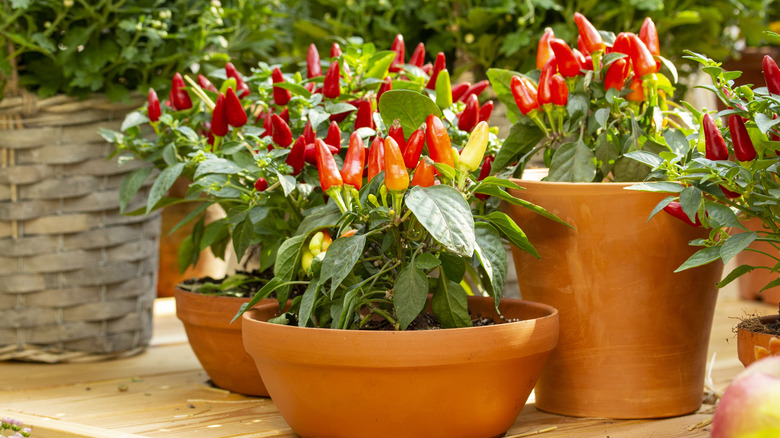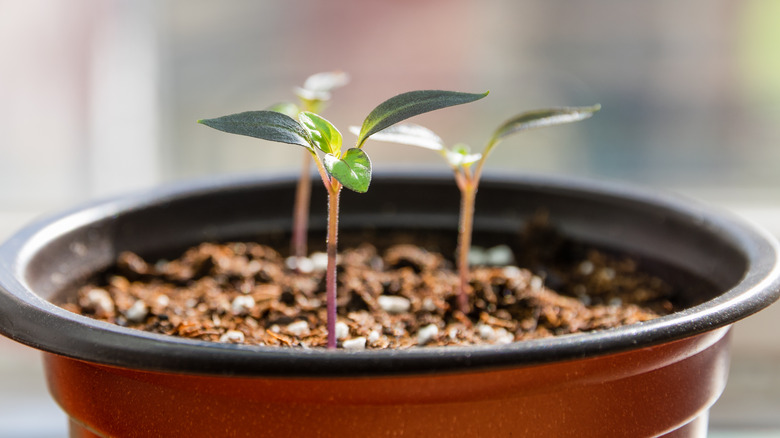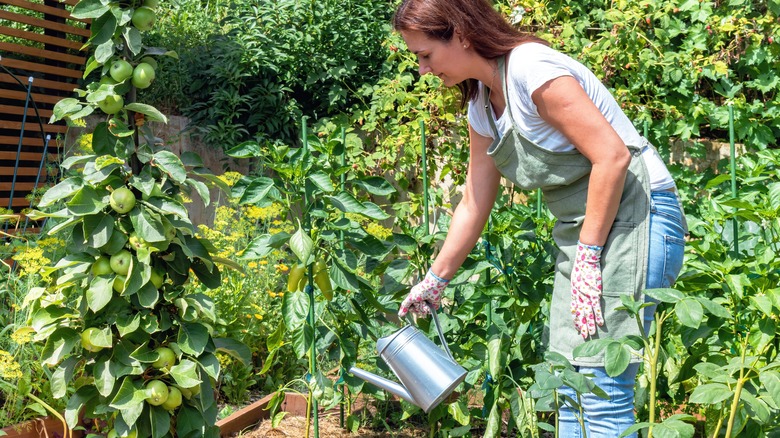You Can Start Fertilizing Your Pepper Plants When You See This
Growing your own pepper plants from seed is a rewarding process and getting your plants off to a healthy start gives them the best chance of having a long and productive season. While it may be tempting to fertilize your peppers as soon as they sprout, it's best to wait a bit. With most seed-starting mixes you should begin fertilizing your pepper seedlings only after the first set of true leaves have begun to form.
There are 5 species of domesticated peppers, all of which are part of the Capsicum genus. While most peppers you're likely to buy or grow, including bells, jalapenos, and poblanos, are part of the Capsicum annuum species, members of the extremely spicy Capsicum chinense species are also popular to grow and include habaneros and the infamous Carolina reaper. Because peppers require warm temperatures and a relatively long growing season, most growers start seeds indoors instead of directly sowing them. Regardless of the type of peppers you're growing, put your seed trays in a warm spot (or use a heat mat) and provide light as soon as your seeds germinate. Pepper seedlings, like most seedlings, grow best in a damp but not soggy growing medium and benefit from a nearby fan to help with air circulation and strengthen the stem.
When to fertilize your pepper seedlings
While some seed starting mixes include fertilizer in them, many others consist of only a medium like peat or coco coir and do not have additional nutrients for your seedlings. Even seed-starting mixes that include some additional nutrients often do not include very much, as too much fertilizer can encourage the growth of the fungus that causes damping off, a disease that kills seedlings. The primary purpose of seed starting soil mix is to provide a loose and fluffy medium so the seedlings' roots can easily grow and spread out. Be sure to check the label on your seed starting mix to avoid accidentally overfertilizing your peppers.
Pepper seeds, like all seeds, contain within them all the nutrients necessary for the plant to begin growing. These nutrients allow the developing plant to survive until the seed leaves or cotyledons develop and can begin to photosynthesize. Because very young pepper seedlings are receiving nutrients from the seed, there's no need to begin fertilizing immediately. It's best to add fertilizer only when the first true leaves appear — usually about a week after you see the seed leaves.
How to fertilize pepper seedlings
While there are a variety of fertilizers available, a liquid fertilizer is generally the best option for young seedlings. It can be either a conventional liquid fertilizer or an organic fertilizer like fish emulsion, although the fishy smell may not be ideal for indoor use. Dilute the fertilizer to a quarter of the strength recommended on the bottle and fertilize about once a week.
Once all danger of frost has passed and your nighttime temperatures are at least 50 degrees Fahrenheit, you're ready to begin preparing to transplant your pepper plants. Be sure to harden off your plants to avoid transplant shock and water them well. Don't forget to perform a soil test on your pepper bed to avoid accidentally under or over-fertilizing your plants during the growing season. Pepper plants are only considered medium feeders, so they require less fertilizer than many other vegetables. In most cases though, they benefit from fertilizing when they are transplanted, and then again after they set fruit.


